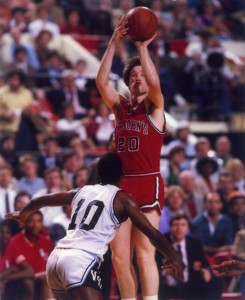State of NCAA Men’s College Basketball is Debatable for What is Best for Game
As the 21st century moves forward, college basketball is becoming more and more known for the early departures. The so called “one and done era” has been alive for more than a decade. Gone are the days when student-athletes made a splash as a freshman and then continued to do so over three or four years in college.
Look no further than Kentucky for proof of this. Since John Calipari was hired as the Wildcats’ head coach in 2009, Kentucky has been the prime source of the “one and done era.” Add in a few sophomores who decided a second attempt at a Final Four or a national championship was worth coming back for and the Wildcats have been a landslide leader in this trend of kids leaving school early for the riches of playing pro basketball.
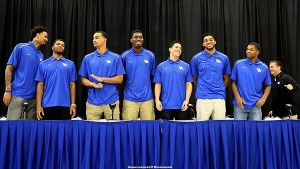
A total of seven Kentucky players declared to enter the NBA Draft earlier this week at a press conference shown here.
Last year was no different. After falling two wins short of becoming the first undefeated national champion in 39 years – following their 71-64 loss to Wisconsin in the 2015 national semifinals – , Kentucky announced that seven players from last year’s team have declared for the NBA draft. Among the seven are four starters including the starting backcourt of sophomores Andrew and Aaron Harrison, freshman center Karl Anthony-Towns, and junior power forward Willie Cauley-Stein. The others are forward Trey Lyles and guard Devin Booker, both freshman, along with 7-foot sophomore center Dakari Johnson.
All seven have the ability to play at the next level as either starters or reserves. Some have the potential to start right away for anybody while the fortunes of others will be influenced by how the NBA Lottery turns out. Early mock drafts have Anthony-Towns competing with Duke freshman center Jahlil Okafor – who has also declared for the draft – for the top overall pick. Anthony-Towns is 6-11 and weighs 250 while Okafor is 6-11 and 270. Both were among the nation’s dominant big men last season.
Should all seven of these players be drafted, it would set a new record for the most players selected from one school in a single draft. The Wildcat’s six selections in the 2012 draft – lead by top overall pick Anthony Davis – is the current record. Davis had lead Kentucky to the national title in 2012 in what was Calipari’s first championship.
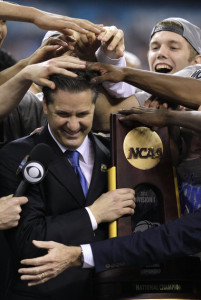
Kentucky coach John Calipari, shown here after he and the Wildcats won the 2012 national championship, has proven he can recruit at the highest level.
Since arriving in Lexington, Calipari has worked wonders. In six full seasons, he has coached the Wildcats to four Final Fours, two national title game appearances, and one national championship. While last year’s team was full of talent with the seven aforementioned players, Calipari has also seen that talent move on rather quickly with a lot of “one and dones.”
After reaching the Elite Eight in 2010, John Wall, Eric Bledsoe, DeMarcus Cousins, Patrick Patterson, and Daniel Orton all departed early. Wall, Bledsoe, Cousins, and Orton were all freshman while Patterson was a rarity who left after his junior year. Kentucky went one step further in 2011, reaching The Final Four before losing to eventual national champion Connecticut in the semifinals. The freshman duo of Brandon Knight and Enes Kanter both left school that year.
In 2012, the Wildcats beat Kansas for the national title. Davis, along with fellow freshmen Michael Kidd-Gilchrist and Marquis Teague, were all “one and done” players. Davis and Kidd-Gilchrist were the top two overall picks, the first time ever that the first two picks were players from the same school. Teague was a late first round pick. Sophomores Terrence Jones and Doron Lamb, were also drafted. Although Kentucky did not even reach the NCAA Tournament in 2013, they still had early departures as center Nerlens Noel and guard Archie Goodwin left after their freshman years.
The Wildcats returned to the national stage with another trip to The Final Four in 2014, this time losing to Connecticut in the championship game. Julius Randle and James Young – both freshman – each declared and were first round draft picks.
That brings us to 2015 and what we just learned with Kentucky having seven players declare for the draft. With six of them either freshman or sophomores, the beat goes on in this trendy tale. Not counting the seven players who just declared for the draft, Calipari has had 18 players drafted over his first five years in Lexington, 13 of them freshman. Josh Harrellson (2011) and Darius Miller (2012) are the other two that were drafted and not mentioned here over this five-year stretch. Each of them made the rare decision to stay in school four years.
While this history makes the Wildcats the kings of the “one and done era,” they are not the only school to face this. Top programs in recent years like Louisville (Gorgui Dieng, Jr.), Michigan (Trey Burke, So., Mitch McGary, So., Tim Hardaway Jr., Jr.), Duke (Jabari Parker, Fr., Rodney Hood, So.), North Carolina (Harrison Barnes, So., Kendall Marshall, So.), Syracuse (Fab Melo, So., Dion Waiters, So., Michael-Carter-Williams, So., Jerami Grant, So., Tyler Ennis, Fr.), Oklahoma (Blake Griffin, So.), UCLA (Jrue Holiday, Fr., Zach LaVine, Fr.), and Kansas (Ben McLemore, Fr., Thomas Robinson, Jr., Andrew Wiggins, Fr.) have all had players leave early. Like Kentucky, most have departed after their freshman or sophomore seasons.
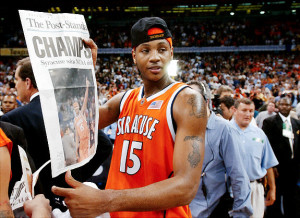
Carmelo Anthony lead Syracuse to the school’s first ever NCAA Championship in 2003 as a freshman and then declared for the NBA Draft soon after.
The “one and done era” emerged in 2003 when freshman superstar small forward Carmelo Anthony lead the Syracuse Orange to its’ first and only national championship with a thrilling 81-78 victory over Kansas. Anthony was the unquestioned star of that team which played sensational in its’ six-game run to the title. Anthony left school after his freshman season and was drafted by the Denver Nuggets with the third overall pick. A trade in late February of 2011 sent Anthony, among others, to the New York Knicks whom he has played for ever since.
In 2007, University of Texas forward Kevin Durant became the first ever freshman to be named the Naismith College Player of the Year. Durant then left school and was the second overall pick in the draft. The 2014 NBA MVP, Durant is largely regarded as one of the top five players in the game today. Since Durant’s “one and done” season at Texas, the “one and done era” has been gaining steam over the better part of the last 10 years.
This sure is in stark contrast to what college basketball was like a generation ago in the 1980’s. Back then players stayed in college for four years. The money wasn’t astronomical as it is today and there was a fonder appreciation for the rivalries and traditions of the game. Players understood the concept of honing their game more at the college level to raise their draft stock and had closer relationships with coaches. The value of an education was even on their minds more. Even though some players go back to finish their degree today, that is more of a lost concept.
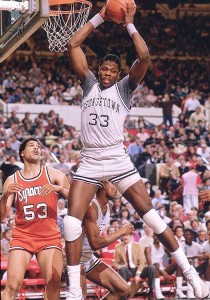
Patrick Ewing was a dominating force for the Hoyas from 1981 to 1985 and helped Georgetown reach three NCAA Championship Games.
Then there are the ideas of winning with the same group, being a veteran team for a couple of years, and winning multiple championships in a four-year span. All that seems forgotten today. Even smaller factors like developing chemistry and being loyal to your school and fans are gone. These concepts are not even considered by most student-athletes today with the luxury of riches awaiting some of them.
Gone are the days of vintage periods of lengthy success for conferences. For example, take the Big East in the 1980’s. What the Big
East had over a four or five year period in the 80’s was a collection of marquee names to not only ignite but sustain rivalries. The Patrick Ewing-Chris Mullin-Dwayne “Pearl” Washington era of the Big East was special. Those players stayed in school for three or four years and helped build their teams into winners year in and year out. By staying in school, these marquee players boosted the television ratings which helped to develop rivalries that lasted for decades.
That trio of players put Big East basketball on the map and laid the foundation for rivalries to grow. Prime players in the late 80’s and throughout the 1990’s carried the torch of long term success. This cast included stars such as Sherman Douglas, Derrick Coleman, Rony Seikaly, Billy Owens, Lawrence Moten, John Wallace, and Etan Thomas at Syracuse.
Plenty of other stars existed as well such as Billy Donovan and Eric Murdock at Providence, Alonzo Mourning, Dikembe Mutombo, and Allen Iverson at Georgetown, and Mark Jackson, Walter Berry, Shelton Jones, and the late Malik Sealy at St. Johns.
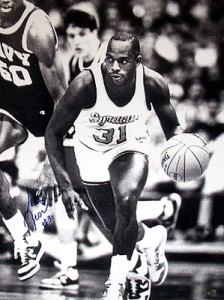
Dwayne “Pearl” Washington was a once in a lifetime player that brought instant attention to Syracuse and Big East basketball.
Others included Chris Smith, Tate George, Donyell Marshall, and Richard Hamilton at Connecticut, Terry Dehere at Seton Hall, Kerry Kittles at Villanova, Troy Bell at Boston College, and Sean Miller, Charles Smith, and Jerome Lane at Pittsburgh. That was an era of basketball that both built the Big East and allowed it to flourish for a very long time.
However you don’t see that same sense of identity in today’s game because of players leaving after their freshman or sophomore seasons. Due to this, the game has lost some of its’ inherent respect. Loyalty is not a priority to student-athletes in today’s age of skyrocketing money. Guaranteed professional contracts and the lure of endorsements have a lot to do with that. Furthermore, the chance for young people to take care of their families and themselves is a huge factor in the decisions that they make.
Yet once and awhile you can still find a credible player who decides to stay in school for three or four years, even if he is really good. The Orange has some good examples here with guys like Wallace, Hakim Warrick, and Rick Jackson. Wallace benefitted from coming back for his senior season in the fall of 1995 and lead Syracuse to the NCAA Championship game. These guys opted to stay in school for four years, get their degree, and improve their draft position.
Sometimes, a player can’t know how good he can be when he is on a team that has so much talent like some of these Kentucky
teams. As some players leave, others should recognize that more playing time or even a starting role could be coming their way meaning opportunities for them to elevate their game. Or perhaps this poses a chance for players to show their well-rounded abilities by taking a different role, whether it is smaller or larger from what they have been used to. For some players, excelling on a team full of so much talent, balance, and depth is not a guarantee of future prosperity on the pro level when you don’t have proof of how you would of done without all that talent and complementary pieces in college. Thus, college success is not always an indicator of the same level of success in the professional ranks.
Players who flop in the NBA and find themselves moving around in the D-League make the mistake of not considering this. Many leave too early without thinking of how another year, two, or three in college could make them better physically as well as mentally.
For any student-athlete to think that they will be as good individually or as a team from one year to the next is inaccurate. With players leaving, the chemistry of a team can change drastically. Perhaps you lose your ace 3-point shooter to graduation or early entry and the team had a great inside-outside combination with him and your sophomore center. Now the center considers leaving as he wonders if defenses will collapse on him more resulting in more double teams that could mean lower production for him. However this is also a chance for the center to work at developing his game and show that he can make his teammates better by getting others involved with the pass. Certainly the center would also look at who they will have as a consistent 3-point threat for the next season in deciding whether to stay in school or leave. However you get the idea here. Some just think it won’t be the same or as good as it was and just decide to leave school. In doing so, they miss out on a chance to further develop themselves.
Or maybe your elite freshman guard who just set a school record for assists is contemplating the “one and done.” Meanwhile, your sophomore forward who was the prime beneficiary of his assists is deciding what to do. In this situation, one player’s decision can determine that of a teammate which can result in a domino effect. These are the finer points that are intertwined in this madness of decision-making.
The bottom line here is that student-athletes are always going to make these decisions based on what is best for them and their life. That aside, work ethic and leadership development are sadly cast aside or overlooked. Many of these student-athletes would be better served to work on these things. Not only for the game of basketball, but for life as well. In terms of just playing pro basketball, they could improve their game and with it position themselves for better prosperity.
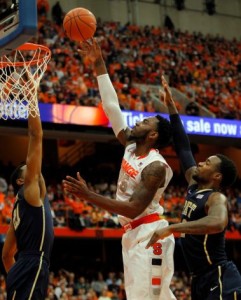
Syracuse graduate student Rakeem Christmas emerged in 2015 as proof that you can develop your game by staying in college for four years.
Rakeem Christmas of the Orange is a great example of this concept. As a freshman during the 2011-12 season, Christmas was on a loaded Syracuse team that was a number one seed in the NCAA Tournament and spent part of the season ranked number one in the country. That Orange team had a veteran backcourt of Scoop Jardine and Brandon Triche along with Fab Melo, C.J. Fair, Dion Waiters, Kris Joseph, and James Southerland, an ace 3-point shooter. Although Melo was ruled ineligible for the NCAA Tournament due to an academic issue, the Orange still reached the Elite Eight that season. Christmas had to play in Melo’s absence in the tournament and hold down the center spot.
Over his four years, Christmas got better by staying the course. For his first three years, he played with many other offensively accomplished players like Joseph, Waiters, Fair, and Southerland. This allowed Christmas to grow each year and thus be better prepared to be a focal point of the offense by the time he was a senior. With frontcourt players like Melo and Jerami Grant leaving after their sophomore seasons, this left a developing player in Christmas a chance to flourish based on being the one mainstay on the frontline.
As a senior, Christmas led Syracuse in scoring (17.5 ppg.), rebounding (9.1 rpg.), and blocked-shot (2.5 bpg.) averages and started all 31 games. It was a significant improvement as Christmas increased his scoring average by 11.7 points from his junior (5.8 ppg.) to senior season (17.5.).
The honors followed with Christmas garnering numerous recognition from the Atlantic Coast Conference and national organizations last year. A first team All-ACC pick, Christmas was also named the Most Improved Player in the ACC and was named the league’s Co-Defensive Player-of-the-Year. In addition, he was selected to the All-ACC Defensive Team. Nationally, he was named to multiple All-American Teams, receiving second team honors from USA Today and third team honors from Sporting News.
All that is a mouthful but very significant for Christmas. Through all this, he has likely worked his way into a first-round pick in the 2015 draft. Although he is not as dominant or as bulky as Okafor or Anthony-Towns, Christmas excels in running the court and rebounding. He is a threat as a shot blocker and by staying in school he developed into an effective low post scorer, something he was not as a freshman. Through the coaching he received and the patience he showed, he developed from a marginal player into a reliable primary scoring option as a senior. This helped him read double teams better and he developed a knack for knowing when to make his own move or pass out of it to the open man. As a result, he learned the value of making his teammates better.
Having said all this, it leaves one to ask, “What is better for college basketball?” What used to be, or the present day standard of so many “one and dones” based on a track record over the last 12 years that has become more trendy in the last six? Loyalty and rivalries built on longevity behind a nucleus of players who stay around for three and four years? Or a win now mentality behind star-power talent that can take your team to the ultimate victory in a year or two? It is something that can go on and on and on in the circles of debate.
